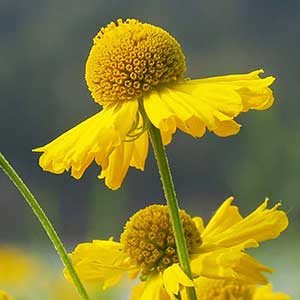Helenium flexuosum
Helenium autumnale
hélénie nudiflore, purple sneezeweed, purple-head sneezeweed
common sneezeweed, fall sneezeweed, hélénie automnale, large-flower sneezeweed, mountain sneezeweed
usually 1, usually branched distally, strongly winged, glabrous or sparsely hairy proximally, sparsely to moderately hairy distally.
1(–7), branched distally, strongly winged, sparsely to densely hairy proximally, moderately to densely hairy distally.
glabrous or sparsely to moderately hairy;
basal blades oblanceolate to obovate or spatulate, entire or serrate;
proximal and mid blades oblanceolate to lanceolate, entire or toothed;
distal blades lanceolate to lance-linear, entire.
usually moderately to densely hairy, sometimes glabrous;
basal blades (withered by flowering) lanceolate, oblanceolate, or obovate, entire or weakly lobed;
proximal and mid blades obovate to oblanceolate, usually dentate or entire;
distal blades oblanceolate to lanceolate, entire or dentate.
3–10 cm, sparsely to moderately hairy.
3–10 cm, moderately to densely hairy.
globoid to usually ovoid, 8–17 × 9–17 mm.
globoid, 8–20 × 8–23 mm.
usually 8–13, neuter, sometimes 0;
corollas yellow to reddish brown to red to purple, 10–20 × 5–10 mm.
8–21, pistillate, fertile;
corollas yellow, 10–23 × 4–10 mm.
250–500(–700+);
corollas yellow proximally and purple distally or purple throughout, 2.3–3.7 mm, lobes 4(–5).
200–400(–800+);
corollas yellow proximally, yellow to yellow-brown distally, 2.4–4 mm, lobes 5.
(connate proximally) moderately to densely hairy.
(connate proximally) moderately to densely hairy.
(1–)5–50(–80+) per plant, in paniculiform arrays.
5–70(–100+) per plant, in paniculiform arrays.
1–1.2 mm, moderately hairy;
pappi of 5–6 entire, aristate scales 0.6–1(–1.7) mm.
1–2 mm, sparsely to moderately hairy;
pappi of 5–7 entire, aristate scales (0.5–)0.9–1.5(–1.8) mm.
= 28.
= 32, 34, 36.
Helenium flexuosum
Helenium autumnale
It has been suggested that Helenium flexuosum may be of hybrid origin from H. campestre (perennial, 2n = 28) and some member of Helenium sect. Tetrodus (H. F. L. Rock 1957). The only member of sect. Tetrodus that has a chromosome number of 2n = 28 is H. linifolium, an annual from southern Texas.
(Discussion copyrighted by Flora of North America; reprinted with permission.)
- Local floras:
BC,
CA,
OR,
WA
- Local Web sites:
CalFlora,
CalPhotos,
Flora NW,
Go Botany,
IL Wildflowers,
KS Wildflowers,
LA Plants,
MD Biodiversity,
MI Flora,
MO Plants,
PNW Herbaria,
Turner Photog.
WildflowerSearch
iNaturalist (observations)
USDA Plants Database
- LBJ Wildflower Center
- SEINet
- Plants of the World Online
- Encyclopedia of Life
- Wikipedia
- Google Image Search


